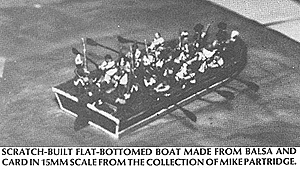WARGAMING FEATURES
 SCRATCH-BUILT FLAT-BOTTOMED BOAT MADE FROM BALSA AND CARD IN 15MM SCALE FROM THE COLLECTION OF MIKE PARTRIDGE.
SCRATCH-BUILT FLAT-BOTTOMED BOAT MADE FROM BALSA AND CARD IN 15MM SCALE FROM THE COLLECTION OF MIKE PARTRIDGE.
Recreation of amphibious assault landings like the ones described previously are not easy. There are two basic difficulties. The first is weather. Landings were always at the mercy of weather. The ships in the Louisbourg campaign arrived in Gabrus Bay on June 2,1758. It was only on June 8th, after several changes of orders, that Boscawen took the risk of landing. After the landing bad weather prevented landing of stores, etc. for several days. At St. Johns, the transport Peggy with provincial light infantry aboard was blown out of the harbor by the wind and these soldiers could not land with the rest. These difficulties can be overcome by assigning wind speeds, wind direction, etc. to dice throws thereby leaving weather to chance.
One factor I have not been able to discover is the speed of the assault boats. Obviously wind, tide, waves, etc. make great differences to such speeds. The best I can do is to suggest that well-manned boats would move at a fast walking pace of about 6-7 miles per hour if in good conditions.
The other major problem is surprise. An attack across a welldefended beach with an alert defender is a very hazardous enterprise. To have a good game it is important that coastal and beach topography should be laid out to give some scope for initiative and surprise and that the beach defenses are not too formidable and are able to be outflanked. Another solution would be if the landing was part of a campaign where strategic decisions have to be made by both sides as to allocation of troops and resources, landing places to defend or attack, etc. This restores the initiative to the attackers as was the case in the 1750s.
The equipment necessary for amphibious operations can be easily added to any mid-Eighteenth Century army. Boats can be purchased commercially or scratch-built out of balsa and card. A compromise over appearance and scale is required as the boats have to carry figures. My boats carry half a battalion, about fourteen miniatures, which in real life required five flat-bottomed boats. It is better to take casualties from passengers in proportion otherwise a lucky shot can sink too large a proportion of the attacking force. Boats can be represented simply by boat-shaped pieces of card upon which figures stand. Warships can be represented similarly with broadside values marked thereon.
Remember that boats were small moving targets. Defensive fire could not have been very effective until the troops were on the beach. At Louisbourg, most casualties were drowned although many sailors were wounded. Total casualties here were small; 61 killed and 112 wounded from both services.
A well-run assault would follow similarly to the rules of the Eighteenth Century.
- 1. Reconnaissance of the beach with calculation of weather.
2. Plans are drawn. These include timing of the assault, choice of the landing place, fire support, etc.
3. Loading and organization of the assault boats while the defenses are bombarded.
4. The landing of the soldiers; elite on the flanks or with a special mission to occupy a hill, etc., line troops in the center followed by concentration of the troops on the beach in their formal formations.
5. The troops form up to resist counter-attacks by volley firing. A successful defense leads to an advance inland.
Some weaknesses to look out for are:
- 1. Poor landing site selection such as one that does not lead anywhere or one that is commanded by a difficult to capture obstacle such as a large hill.
2. Inability to suppress defensive fire.
3. Scattering of assault boats by bad weather or defensive fire.
4. Units on the beach unable to form up at all or in sufficient numbers.
In this way, you too can expand the British Empire!
REFERENCES
Clowes, P., "The Siege of Louisbourg". Miniature Wargames No. 32.
Fyers, Major E.W.H., "The Loss and Recapture of St. Johns, Newfoundland in 1762". Journal of Army Historical Research. Volume IX.
Gipsom, H.L., The Great War for Empire (part 2) Vol. III.
Grinnel-Milne, Mas is He? The Character and Achievement of James Wolfe. 1963.
Hitsman, I.M. and Bond, C.C.I., "The Assault Landing at Louisbourg 1758". Canadian Historical Review. Volume XXXV, Dec. 1954.
Syrett, D., "The Methodology of British Amphibious Operations During The Seven Years and American Wars". Marines Mirror volume 58, 1972. This piece also appears in Assault From The Sea by The Naval Institute Press.
British Amphibious Operations in North America 1758-1762.
Back to Table of Contents -- Courier Vol. VIII No. 2
To Courier List of Issues
To MagWeb Master Magazine List
© Copyright 1988 by The Courier Publishing Company.
This article appears in MagWeb (Magazine Web) on the Internet World Wide Web.
Other military history articles and gaming articles are available at http://www.magweb.com